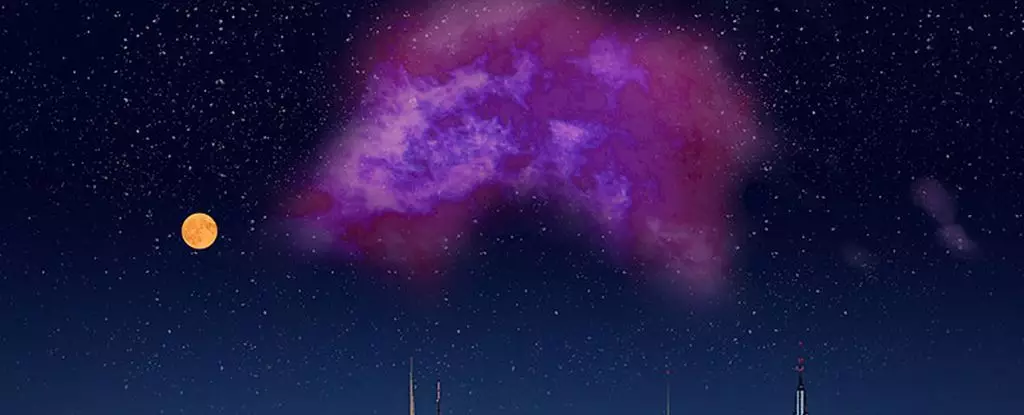In a groundbreaking revelation that has stirred excitement in the astrophysics community, scientists have unveiled a colossal object hiding in the shadows of interstellar space. Situated just 300 light-years away from Earth, this vast crescent-shaped cloud of molecular hydrogen, aptly named Eos after the Greek goddess of dawn, represents a significant leap in our understanding of cosmic structures. For centuries, astronomers have gazed at the twinkling stars and the pitch-black void between them, remaining blissfully unaware of the hidden treasures that lurk in those seemingly empty spaces. This discovery changes that game, providing a fresh perspective on the nature of our universe.
Seeing the Invisible
This achievement marks a historic milestone in astrophysics as it represents the first documented finding of molecular material in interstellar realms through the detection of far-ultraviolet light emitted by these gas clouds. Astrophysicist Blakesley Burkhart from Rutgers University states a compelling fact: “This cloud is literally glowing in the dark.” It is a simple yet profound statement that encapsulates the wonder and enigma surrounding interstellar phenomena.
For long, scientists relied heavily on carbon monoxide as a tracer to detect molecular clouds. However, much of the interstellar medium is composed of hydrogen atoms, which tend to be overlooked, simply because they don’t emit the same detectable signals. This presented a significant gap in our understanding of star formation and the lifecycle of galactic material. Burkhart and her team adopted an innovative methodology by analyzing data collected from South Korea’s STSat-1, a ultraviolet space telescope, shifting the unique focus to far-ultraviolet emissions of molecular hydrogen. This unconventional approach unveiled Eos, allowing researchers to map its dimensions and structural characteristics.
A Glimpse into Cosmic Birthplaces
The Eos cloud has an imposing diameter that stretches approximately 80 to 85 light-years across. Within this vast expanse resides around 2,000 solar masses of hydrogen—an astounding figure that symbolizes a fraction of the universe’s molecular essence. If visible from Earth, Eos would command attention in the night sky, appearing 40 times wider than the full moon. Long shrouded in obscurity, these areas of interstellar space are crucial for understanding how stars and planets coalesce from gas and dust.
As the researchers delved deeper, they discovered that the hydrogen in Eos was undergoing photodissociation, meaning that the energy emitted by nearby stars was essentially ‘evaporating’ the cloud. This ongoing process dissipates roughly 600 solar masses per million years, indicating that Eos is on a ticking clock, destined to fade away in about 5.7 million years. This timeline, while vast by human standards, is a fleeting moment on the cosmic scale, underscoring the transient nature of molecular clouds.
Revolutionizing Our Understanding of the Galactic Landscape
The implications of this discovery stretch far beyond the confines of Eos. Burkhart expressed the excitement felt by researchers: “We can now directly measure how molecular clouds are forming and dissociating.” This newfound understanding provides crucial insights into how galaxies transform interstellar gas into stellar housing, leading to the formation of solar systems that could one day host life.
Furthermore, the technique employed to discover Eos could serve as a universal blueprint for detecting other invisible molecular clouds scattered throughout the Milky Way galaxy and beyond. The far-ultraviolet fluorescence emission methodology opens doors to uncharted territories of cosmic research, enabling scientists to revisit previous assumptions about star formation’s mechanics and the overall structure of the galaxy.
Bridging the Gaps in Cosmic Knowledge
Cosmologist Thavisha Dharmawardena emphasizes the transformative potential of this discovery, suggesting that it could alter our understanding of the interstellar medium fundamentally. The ability to uncover previously hidden clouds enables us to address fundamental questions about the lifecycle of molecular hydrogen and its roles throughout cosmic history. Each discovery, like Eos, adds another brushstroke to the grand painting of our universe, helping to explain how the ethereal fabric of space is woven from invisible threads.
As we look forward to future research stemming from this groundbreaking discovery, it becomes clear that the cosmos is anything but empty. Instead, it is brimming with hidden wonders, waiting to be revealed—a reminder of how much we have yet to learn about the universe and our place within it.


Leave a Reply